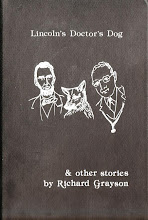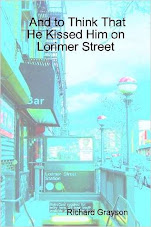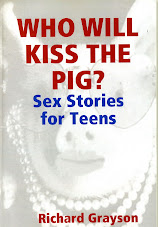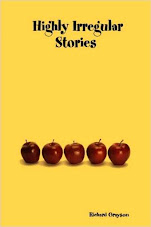
We've just returned from a wonderful evening of great performances, informative and moving talks, and free HIV testing at El Puente, Williamsburg's venerable human rights institution and community center, as part of the observance of Latino AIDS Awareness Day.
Presented by Teatro El Puente, "LIVE: A Labor of Love," was aimed at the community's teens, and except for one cranky guy who was afraid he'd be mistaken for someone's abuelo and few other older people, nearly all of the about ninety or so audience members in the El Puente auditorium looked between 14 and 19.

Of course, anyone involved in AIDS education among adolescents knows that Teatro El Puente was a pioneer in employing the arts and peer education since its 1987 founding as the first educational AIDS theater company for adolescents in New York City. (At Teachers College in the summer of 1990, we learned about them when we took a class in AIDS Education and Human Sexuality - one that certified public school teachers for the Board of Ed's curriculum in family living and sex education.)
The main room of El Puente downstairs has a slightly raised stage - a huge red AIDS ribbon was raised over it tonight - and the audience sat in comfortable chairs in two rows. We were lucky enough to get a good aisle seat . There was a DJ in one corner throughout the show, which was incredibly professional, given that the people running it were, to our ancient eyes, very young.

The MCs of the evening, Teatro El Puente's Nikki and Jordan Figueroa, showed real aplomb not just in moving the show along but in their interactions with the audience and the "freshest, dopest" performers who were energetic, feisty and soulful.
Jordan performed a moving monologue about being a five-year-old watching his HIV-positive mom and others shoot up in their apartment and about losing her just three years ago when he was 15. So it's imperative that because the disease affects numerous others besides those who are ill that we all make sure not to engage in risky behavior:
You make the wrong decision,
AIDS targets you with such precision
that it's too late

None of what we heard about AIDS/HIV during the course of the evening seemed saccharine or condescending, and it was clear that the kids in the audience got it. Periodically some of the health workers would walk up and down the aisle during the show holding papers with numbers - 013, 022, 018 - and those kids who were given those numbers got up and went back to be tested in a private room.
After some great moves by Raje Entertainment's N-FINI-T hip-hop dancers, the first solo performer onstage was Robin DeJesus, whose talent we first spotted four years ago at the Gateway Theater in Fort Lauderdale when we saw his amazing performance in the bouncy movie musical Camp in which he played the drag-queen kid rejected by his family.

Robin first performed a charismatic rendition of "I'll Cover You," the love song he first did years ago when he understudied the part of Angel in Rent. This year he got a Tony nomination for his featured performance as Sonny in In the Heights.
Joking about putting on his "drama face," Robin then sang "Corner of the Sky," which he did every bit as skillfully as we can recall John Rubinstein singing it on Broadway in Pippin back in the early 1970s when we were not much older than the kids at El Puente were tonight.
Next, George, a speaker from Love Heals, the Alison Gertz Foundation for AIDS Education. We remember Ali Gertz well: about 20 years ago, she was a prominent AIDS educator who went public after discovering had gotten HIV from her first sexual experience at 16. George talked about how AIDS was first discovered in 1981 and how AIDS was first considered only a gay disease.

We recall first hearing about GRID - "Gay-Related Immune Disorder" - and HIV was "HTLV-III," as it is in our story "I Survived Caracas Traffic," originally published in Florida Review in 1987, later the title story of our 1996 collection. (Self-serving plug: Kirkus Reviews called the story "a resonant meditation on the themes of relationships, AIDS, and mortality.")
Having been gay and living in both South Florida and Manhattan back in the 1980s, we sometimes felt the epidemic would never end. George spoke about being an 18yo Cuban-American from Miami who came up to New York in 1986 to work in a Manhattan hair salon, where he met his friend Steven, also Cuban, the first person he knew who had AIDS.

Like too many of our own friends, Steven was down to 97 pounds in six months and barely hanging on in a hospital where the nurses were afraid to enter his room, where Steven's mom would sit night and day. George described sitting with her at his friend's side and how Steven's skin turned gray, something George could only think of as part of a process of the rotting of his body.
Then, one day while George was there, Steven - who hadn't lifted his head in days - suddenly shot up in bed and said "Michael!" - the name of his dead boyfriend - and just as suddenly laid back dead. "I can't describe to you what the air feels like when you're in a room where someone's life leaves his body," George told the crowd.

Cognizant of the dangers by the many friends who died - George took out a sheet of paper and read the first names of those whose memorial services he attended in just one year in the mid-1980s: men, women, gay, straight, white, black, Latino, Asian, maybe twenty in all - George made sure to be safe. That is, until years later, when unlike in the 1980s you weren't seeing sick people everywhere, when George got drunk one night at a bar and met a cute guy.

That one unsafe encounter led to his testing positive for HIV, and although George looks great and healthy - he just had the eleventh anniversary of surviving with the virus - he discussed how angry his friends became because of their own worry for his health and how the "miracle" drugs that keep him OK once caused an allergic reaction in which his liver swelled, he ran a high fever and almost died in the nine days he was in intensive care.
He told the kids he still has permanent nerve damage and then he took out a card that he carries which states that he takes medication that can cause this kind of allergic reaction at any time, without warning. The audience was very quiet as George said that no one should have sex without a condom or latex barrier and that if you can't talk about condoms with your partner, then you're probably not ready to have sex with them.

The thing is, condoms do work, and George gave as an example his HIV-negative boyfriend who's lived with him for three years. He told everyone to read the instructions for condoms when you've still got your clothes on. The audience laughed, but they got it.
The MC's thanked George and Love Heals and the kids applauded. With some more talk about HIV, the evening then switched to pure entertainment for a while with Quad Divino, a vibrant and sensuous quartet of dancers, two guys and two women.
Next up was the versatile Khalid Rivera, who's been number one several times on MTV Logo's Click List.

If you've never seen Khalid's vid of "Every Nite," you can catch it here, but we've got to say he's even hotter performing it live.
The single of "Every Nite" is, we think, number one on the Canadian charts. Khalid also sang a great version of "How Do U Mend a Broken Heart" and ended his set with a terrific song he performed with Nikki and Shanelle.
After the crowd gave it up for Khalid, Anny Mariano of Teatro El Puente portrayed, in one of the troupe's new plays, a feisty young woman who accompanies her friend to get tested for venereal disease and to her surprise - the character has only been with one guy, the father of her son, who's currently in jail - she tests positive for HIV.

Anny Mariano gave a terrific performance as someone going through all the stages known to those of us with friends and family who've received this diagnosis: denial, anger, and finally understanding and acceptance. The scene she did with Jordan Figueroa, playing her boyfriend who finally admits he's had sex with a guy while incarcerated, was riveting.

Anny's monologue ended back in the health clinic as she comes back to talk to the woman who'd given her the HIV test news weeks or months before (and who she'd cursed out with energetic rage). She (and Jordan) received a lot of well-deserved applause.
The bouncy star of the new PBS Electric Company - premiering in a couple of months - rapper P-Star bounded onstage next with five backup dancers, three other women and two younger boys, all wearing different colored P-Star T-shirts.

A star since she was about 6 - like a whole seven years ago - P-Star is a dynamic one-girl entertainment industry as a rapper, actress, dancer, choreographer, host of TV's Teen Diaries - and she's even got her own exercise DVD!
She gave us an energetic show with audience participation. "Where you at?!" P-Star shouted.
"Brooklyn!" we all shouted back.
It wasn't loud enough for P-Star, so we kept shouting "Brooklyn!" until the decibels were deafening and P-Star said, "Brooklyn, make some news!" Um, okay. We admit, like her song says, she's cool, cool, cooler than us.
The next performer up was Fascious, the writer/performer who's a member of The Intangibles Spoken Word Collective, Nuyorican Poets Café Grand Slam Finalist (2007) and two-time Northeast Regional Poetry Slam Champion (2007, 2008).

Fascious talked about people's lingering false perceptions of AIDS as a disease of Africa or of white gay men before doing a moving poem about being with his dying grandfather when he was a kid who learned chess from the old man. Fascious is a hypnotic performer, as you can see on this video of "Chess":
The next featured speaker, Frances Lucerna, was introduced as "the mother of El Puente" - more formally, she's its executive director - and she took the stage to much applause from her kids and members of the community. She said she was truly honored to be their "mother" at the evening's "celebration of life."
Like us, Frances Lucerna said she was taken aback by the tremendous talent onstage and how skillfully everyone had worked on the show. George's story had touched her, she said, and she remembered how in the 1980s, with AIDS devastating New York, it sometimes seemed like the end of the world. We remember. . .

El Puente lost a lot of members, and Frances said she, like George and many of us of a certain age and a certain community, attended more memorial services than anyone should in just the space of a few years. She mentioned Angel and Andy, who worked hard at El Puente, and how we have to honor people like them by taking up our responsibilities and getting word out about HIV in the community - the way Teatro El Puente has been doing since 1987, when it was established as the AIDS Drama Project.
Back then people were skeptical of doing HIV education for teens and young adults through drama performances, but today "the El Puente way" is the model for such programs not only in the U.S. but around the world. Teatro El Puente has taken their message to thousands of people over the past couple of decades, and Frances exhorted the audience to "tell the story, make a difference, make a commitment, make the right choices."

To warm applause, Frances Lucerna thanked everyone for coming together as a community to "celebrate our lives and our talents." And she ended with the hope that we can look forward to the day when we won't need to do AIDS Awareness Days, when the disease will be just a memory.
The evening ended on a high note with an energetic performance by Anthony Rodriguez and La Santa Luz Dance Company, of which he's artistic director.

Anthony was also a featured dancer on the 2001 Madonna Drowned World Tour, and has worked for Prince, Cyndi Lauper, Marc Anthony and Tito Puente. You can check out Anthony's moves here and you'll understand why the crowd at El Puente went wild.
Okay, not really wild. Not for teenagers anyway. Actually, the thing that most impressed us about tonight's event wasn't even the great performers or speakers but the kids in the audience at El Puente and those in Teatro El Puente who worked so hard on creating a great show. We saw several dozen kids get up during the show to go back to get HIV tests and, we know, some counseling.
Hey, even we took some of the condoms on the front table as we went out into the Williamsburg night. Thanks to everyone at El Puente and Teatro El Puente, particularly to Theresa Doherty for letting us know about this great event.














































































